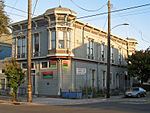Amtrak Oakland Maintenance Facility
Amtrak facilitiesRail yards in CaliforniaTransport infrastructure completed in 2004Transportation in Oakland, CaliforniaUse mdy dates from August 2023

The Amtrak Oakland Maintenance Facility is a passenger train servicing depot in Oakland, California. It is located on the Union Pacific Railroad Niles Subdivision, 1.8 track miles (2.9 km) north of Oakland–Jack London Square station. It provides maintenance for Amtrak's regional and long-distance trains in northern California, including the California Zephyr, Capitol Corridor, and San Joaquins.
Excerpt from the Wikipedia article Amtrak Oakland Maintenance Facility (License: CC BY-SA 3.0, Authors, Images).Amtrak Oakland Maintenance Facility
3rd Street, Oakland West Oakland
Geographical coordinates (GPS) Address Nearby Places Show on map
Geographical coordinates (GPS)
| Latitude | Longitude |
|---|---|
| N 37.8013 ° | E -122.2934 ° |
Address
3rd Street 1303
94607 Oakland, West Oakland
California, United States
Open on Google Maps





